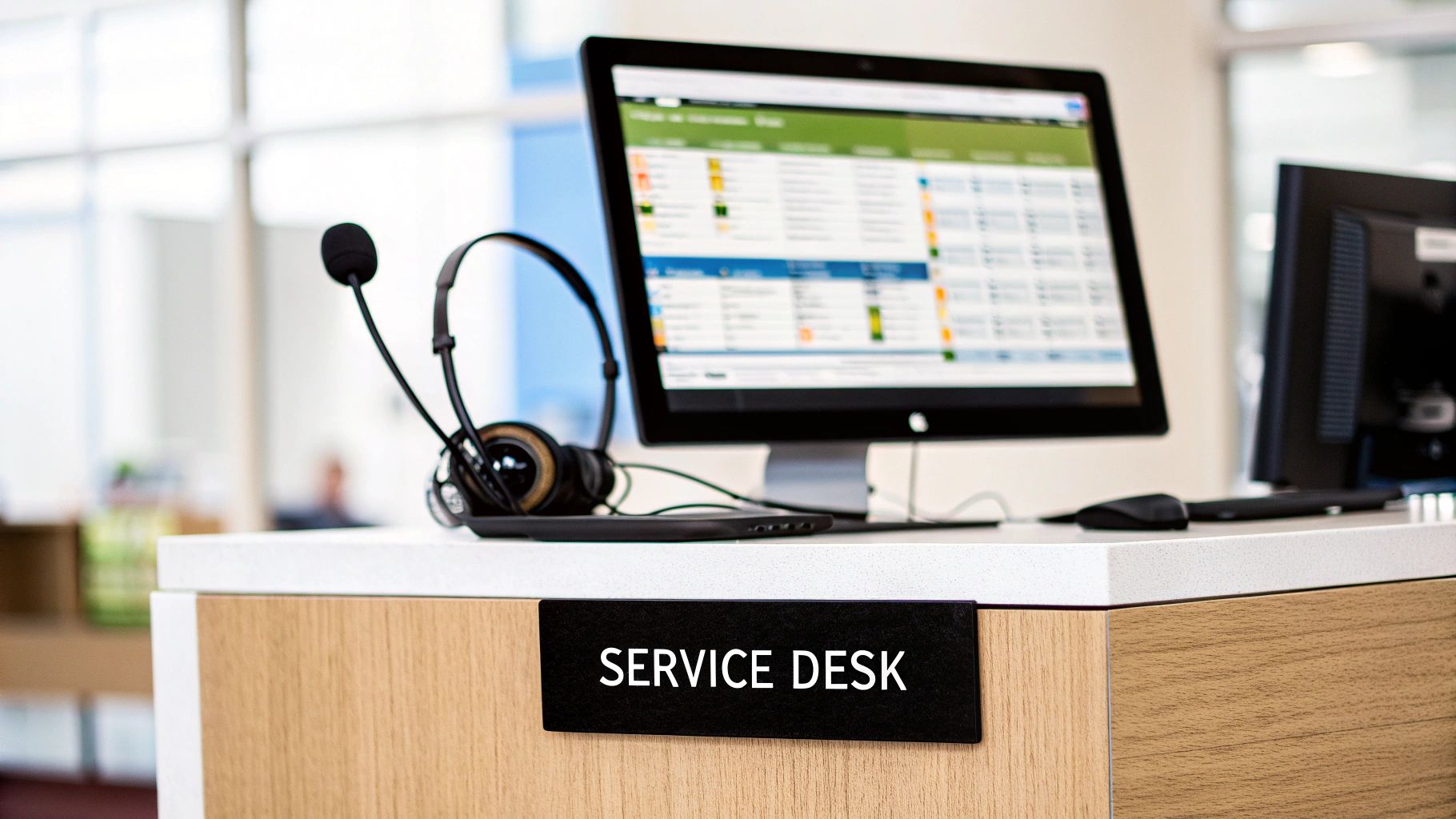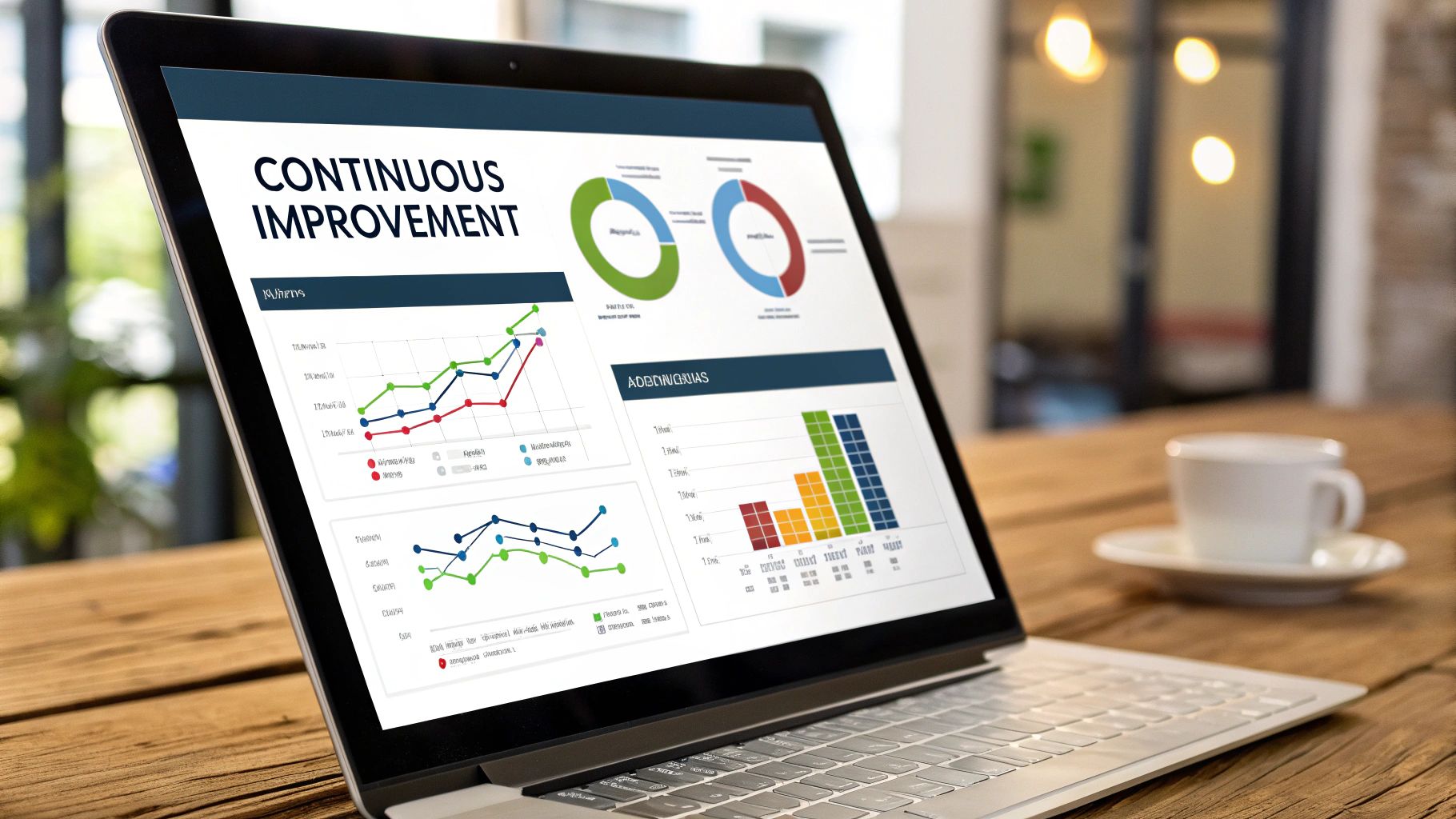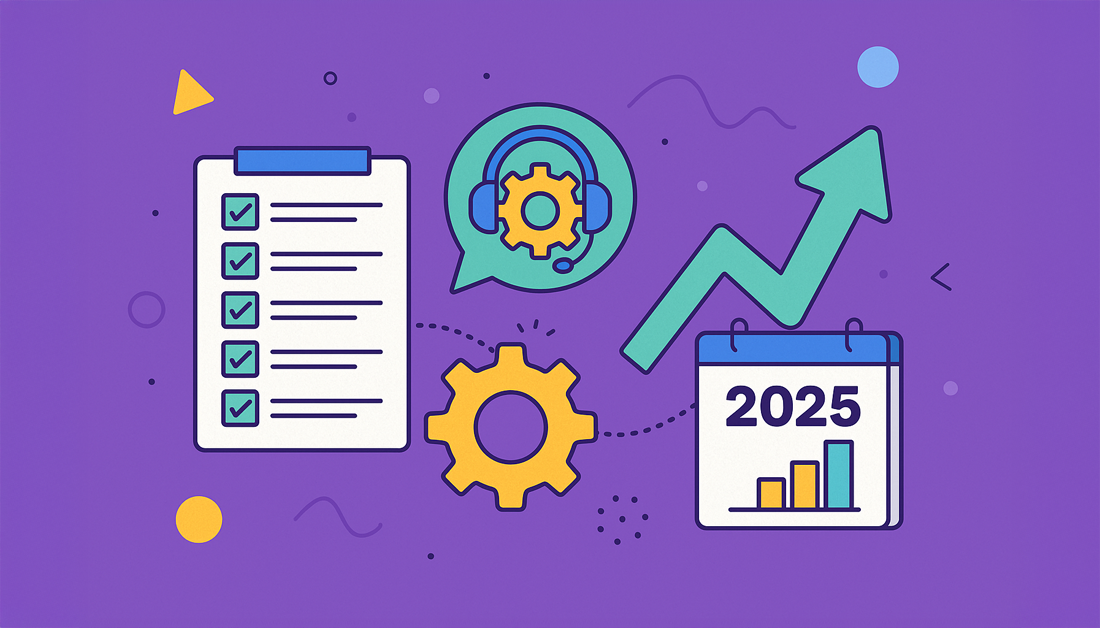Stuck in a cycle of endless tickets and firefighting? It's a common story in IT. But what if your IT department could transform from a reactive cost center into a proactive, value-driving engine for the entire business? The secret isn't more tools or bigger budgets-it's about adopting a smarter, more strategic approach.
True IT Service Management (ITSM) is more than just closing tickets; it's a philosophy designed to align every single IT action with tangible business outcomes. It’s the difference between simply fixing a broken laptop and ensuring the sales team has the reliable technology it needs to hit its quarterly targets. This is where mastering ITSM best practices becomes a business superpower, not just an IT responsibility.
This guide cuts through the noise to deliver 8 powerful ITSM strategies that are genuinely changing the game. We'll move beyond generic advice and dive into actionable tactics, complete with real-world examples and specific ways to implement them using tools you already use, like Atlassian's Jira Service Management. Get ready to shift your mindset, streamline your processes, and finally prove the strategic value of your IT services. Let's get started.
1. Adopt a Service-Oriented Mindset
Stop thinking of IT as the department that fixes laptops and resets passwords. It's time to rebrand. Adopting a service-oriented mindset means shifting your entire perspective from managing technology to delivering valuable services. Instead of focusing on server uptime percentages, you start focusing on how that uptime helps the sales team close deals faster. It’s one of the most fundamental ITSM best practices because it aligns every IT action with tangible business outcomes.

This isn't just about being nicer to your colleagues. It's a strategic overhaul, championed by frameworks like ITIL and proven by giants like Microsoft, which pivoted from selling software in a box to delivering the continuously updated Office 365 service. Your "customers" are your fellow employees, and your "products" are the services you provide, like "New Employee Onboarding" or "Marketing Campaign Server Access."
How to Make the Shift
Getting started doesn't require a complete teardown of your department. Begin with small, impactful changes:
- Map the Customer Journey: Grab a whiteboard and trace the steps an employee takes to request and receive an IT service. Where are the friction points? Where do they get frustrated? This exercise alone will reveal dozens of opportunities for improvement.
- Create Value-Driven SLAs: Ditch meaningless technical metrics in your Service Level Agreements (SLAs). Instead of "99.9% network uptime," frame it as "Sales CRM will be available 99.9% of the time during business hours." This connects your work directly to business operations.
- Implement Feedback Loops: Use tools like Jira Service Management to automatically send out a simple satisfaction survey after a ticket is closed. This provides a constant stream of data on customer perception.
Key Insight: A service-oriented mindset isn't a project with an end date; it's a cultural transformation. It redefines IT's role from a cost center to a value-creation partner, making your team indispensable to the business's success.
2. Implement Robust Change Management
Uncontrolled changes are the gremlins of the IT world, causing outages at the worst possible moments. Robust change management isn't about creating bureaucratic roadblocks; it's about creating a safe, predictable, and efficient way to evolve your IT services without breaking things. It’s a structured process for planning, authorizing, testing, and deploying any modification, from a simple patch to a major system overhaul. This approach is a cornerstone of modern ITSM best practices, turning potential chaos into controlled progress.

Look at tech giants like Amazon and Netflix. They don't succeed by avoiding change; they succeed by mastering it. Amazon's highly automated change management for AWS allows thousands of changes daily, while Netflix’s continuous deployment pipeline is a model of engineering excellence. They treat change not as a risk to be avoided but as a process to be optimized, which is the secret to both stability and innovation.
How to Make the Shift
You can implement a solid change process without slowing your teams to a crawl. The goal is velocity with guardrails:
- Categorize Your Changes: Not all changes are created equal. Use a risk-based approach to create categories like Standard (pre-approved, low-risk), Normal (requires review), and Emergency (for immediate incident resolution). This ensures you apply the right level of scrutiny.
- Automate Where Possible: Use tools like Jira Service Management to automate the approval workflow for standard, low-risk changes. If a team requests a pre-approved software installation, the system can handle the entire process without manual intervention. You can discover practical ways to set this up in Jira to get started.
- Establish a Change Calendar: Create a shared, visible calendar that shows all upcoming changes. This simple tool prevents conflicts, informs stakeholders, and gives teams like marketing a heads-up before a planned system update impacts their campaign launch.
Key Insight: Effective change management isn't about saying "no." It's about creating a framework that empowers your organization to confidently say "yes" to the right changes at the right time, minimizing disruption and maximizing value.
3. Establish Comprehensive Service Level Management
If a "service-oriented mindset" is the philosophy, then Service Level Agreements (SLAs) are the binding contracts that make it real. Establishing comprehensive service level management is about moving beyond vague promises and creating documented, agreed-upon standards for service delivery. It’s the difference between saying "we'll fix it soon" and guaranteeing "P1 incidents will have a first response within 15 minutes." This is one of the most critical ITSM best practices because it builds trust and provides a clear, objective measure of performance.

This isn’t just an ITIL-nerd obsession; it's a standard practice for any high-performing service provider, from cloud giants like AWS and Microsoft Azure to your own internal IT department. Properly defined SLAs, OLAs (Operational Level Agreements), and Underpinning Contracts (UCs) create a chain of accountability. They ensure everyone, from your software vendors to your internal network team, is aligned on delivering the final service promised to the end-user.
How to Make the Shift
You don't need a team of lawyers to get started. Effective service level management is about clear communication and realistic goals.
- Start with Business Outcomes: Don't pull metrics out of thin air. Sit down with department heads and ask, "What does 'good service' look like for you?" A finance team might prioritize the availability of their accounting software at month-end, while sales needs the CRM to be lightning-fast during business hours.
- Use Templates and Automation: Tools like Jira Service Management have built-in SLA clocks that automatically track time against targets. You can set up policies like "Time to resolution for High-Priority requests < 8 business hours" and let the tool manage the tracking and notifications, making it easy to see what's on track and what's at risk.
- Review and Refine Relentlessly: An SLA is a living document, not a stone tablet. Schedule quarterly reviews with your business stakeholders. Did you meet the targets? Were they the right targets? Use the data from your ITSM tool to have an informed discussion and adjust as business needs evolve.
Key Insight: Great SLAs aren't about punishing failure; they're about defining success. They transform IT's relationship with the business from a subjective one based on perception to an objective partnership based on shared, measurable goals.
4. Develop a Centralized Service Desk
Say goodbye to the wild west of IT support, where requests come in via shoulder taps, frantic emails, and sticky notes left on monitors. A centralized service desk establishes a single, organized front door for all user interactions with IT. It’s the primary interface where users report incidents, request new services, and ask for information, transforming chaotic support into a streamlined, measurable process. This isn't just a glorified help desk; it's the nerve center of your IT operations and a core tenet of effective ITSM best practices.

The concept, popularized by ITIL and expertly implemented by platforms like Atlassian's Jira Service Management, ensures every request is captured, prioritized, routed, and resolved efficiently. Instead of five different people getting asked about the same Wi-Fi issue, one ticket is created, a knowledge base article is shared, and the problem is fixed for everyone. It provides consistency, accountability, and a treasure trove of data about what your users actually need from IT.
How to Build Your Command Center
Centralizing support is a game-changer for both your team and your users. Here’s how to get started:
- Implement Self-Service Options: Create a user-friendly portal with a knowledge base that empowers users to solve common issues themselves, like password resets or software installation guides. This deflects a huge number of tickets, freeing up your agents for more complex problems.
- Automate Routine Tasks: Use the workflow automation tools within your service desk software to handle repetitive tasks. For example, automatically route all new hardware requests to the procurement team or assign software access requests based on department.
- Train Your Team on More Than Tech: Service desk staff are the face of IT. Train them not just on technical troubleshooting but also on customer service, empathy, and communication. They need to be great problem-solvers and great communicators.
- Measure What Matters: Focus on key performance indicators (KPIs) that reflect user satisfaction and efficiency. Track metrics like first-call resolution, time to resolution, and customer satisfaction (CSAT) scores to continuously improve. Learn more about powerful service desk key performance indicators on resolution.de.
Key Insight: A centralized service desk does more than just organize tickets. It provides a single source of truth for IT demand, enabling data-driven decisions, proactive problem management, and a consistently positive user experience across the entire organization.
5. Implement Proactive Problem Management
Stop playing whack-a-mole with recurring IT issues. While strong incident management is crucial for putting out fires, proactive problem management is about fireproofing the building. This practice shifts your team from a reactive state to a predictive one, hunting down the root causes of recurring incidents before they can disrupt the business again. This is one of the most high-impact ITSM best practices because it directly reduces incident volume, frees up your support team, and boosts overall service stability.
This isn't about blaming individuals; it's about dissecting processes and systems. Instead of just closing yet another "printer not working" ticket, problem management asks why that printer model consistently fails. It’s a detective-like approach championed by frameworks like ITIL and put into practice by tech giants like Google through their Site Reliability Engineering (SRE) principles, where they relentlessly analyze outages to prevent recurrence.
How to Make the Shift
You don't need a team of data scientists to start. Begin by focusing on your most frequent and disruptive incidents:
- Analyze Incident Data: Use your ITSM tool, like Jira Service Management, to run reports on recurring incidents. Look for patterns. Is a specific application causing the most tickets on Monday mornings? Is a certain piece of hardware failing more than others? This data is your treasure map to underlying problems.
- Establish a Known Error Database (KEDB): Once you've identified a root cause but don't have a permanent fix yet, document it in a KEDB within Confluence. This database gives your service desk immediate workarounds, drastically speeding up resolution for future related incidents.
- Prioritize with Business Impact: You can't fix everything at once. Create a simple matrix to prioritize problems based on their frequency and business impact. A problem that brings down the payment processing system once a quarter is more critical to solve than one that causes a minor inconvenience daily.
Key Insight: Proactive problem management transforms your IT team from perpetual firefighters into strategic architects of a more reliable system. It's the difference between constantly patching a leaky boat and building a better one. By resolving the source of issues, you invest in long-term stability and business continuity.
6. Establish a Configuration Management Database (CMDB)
Imagine trying to solve a city-wide power outage without a map of the electrical grid. That's what running IT without a Configuration Management Database (CMDB) feels like. Establishing a CMDB means creating a single source of truth that documents all your IT assets and, crucially, the relationships between them. It’s one of the most powerful ITSM best practices because it provides the context needed to understand the true impact of any change or incident.
This isn't just a fancy spreadsheet of your servers. A proper CMDB, a core tenet of ITIL, tells you that a specific server hosts a particular database, which supports the company's CRM application, which is vital for the sales team. When that server goes down, you instantly know the business impact. Tools like Jira Service Management can integrate with asset management and discovery tools, turning your CMDB into a dynamic, interconnected map of your entire IT ecosystem.
How to Build Your CMDB
The thought of cataloging everything can be paralyzing, but you don't have to boil the ocean. Start small and build momentum.
- Start with Critical Services: Don't try to catalog every mouse and keyboard on day one. Identify a single, high-value business service, like your e-commerce platform. Map out every component (servers, databases, applications, network gear) that supports it.
- Leverage Automated Discovery: Manually updating your CMDB is a recipe for failure. Use automated discovery tools, which can be found as integrations or standalone solutions like Lansweeper, to scan your network and automatically populate and update your asset information. This keeps your data fresh and accurate.
- Define Clear Ownership: Every asset or "Configuration Item" (CI) in your CMDB needs a designated owner. This establishes accountability for keeping the information current and ensures data governance isn't just an abstract concept.
Key Insight: A CMDB transforms your IT operations from reactive to proactive. It's the foundation for mature incident, problem, and change management, allowing you to assess risk accurately and restore service faster because you understand how everything is connected.
7. Implement Continuous Service Improvement (CSI)
Good enough is never good enough. Implementing Continuous Service Improvement (CSI) means you stop treating IT services as "finished" projects and start viewing them as living systems that can always be better. It's the practice of systematically seeking out and making incremental enhancements to IT services, processes, and tools. This is one of the most vital ITSM best practices because it ensures your IT department doesn’t just keep up with the business; it helps drive it forward.
This philosophy is borrowed from manufacturing giants like Toyota with their "Kaizen" approach and is a core principle of modern DevOps and Agile methodologies. Instead of waiting for a major failure or a biannual review to make changes, CSI encourages a culture of constant, small-scale improvements. It’s the difference between a massive, risky system overhaul and a series of small, low-risk tweaks that compound into massive gains over time.
How to Make the Shift
You don't need a dedicated "Improvement Department" to get started. CSI is a mindset that everyone on the team can adopt.
- Use Data to Drive Decisions: Don't rely on gut feelings. Dive into the analytics in your Jira Service Management dashboard. Are ticket resolution times creeping up for a specific service? Are satisfaction scores dipping? Use this data to pinpoint exactly where to focus your improvement efforts. For more on this, explore key metrics for continuous improvement.
- Run Improvement "Sprints": Borrow a page from the Agile playbook. Dedicate a short, focused period (like two weeks) to tackling one specific problem. Maybe it's streamlining the approval workflow for new software requests or creating better knowledge base articles to reduce common tickets.
- Celebrate and Communicate Wins: When an improvement pays off, broadcast it! Did a small change to a request form cut ticket creation time by 30%? Share that success in a team chat or a company-wide newsletter. This builds momentum and shows the tangible value of CSI.
Key Insight: Continuous Service Improvement isn't about chasing perfection; it's about making consistent progress. It transforms your team from reactive firefighters into proactive problem-solvers, ensuring your IT services continually evolve to meet and exceed business expectations.
8. Integrate ITSM with DevOps Practices
Stop seeing your ITSM change control board as the mortal enemy of your fast-moving DevOps teams. It's time to build a bridge, not a bigger wall. Integrating ITSM with DevOps means blending the agility and speed of development with the stability and governance of operations. Instead of Change Advisory Board (CAB) meetings being a roadblock, they become automated checks within a CI/CD pipeline. This is one of the most critical ITSM best practices for modern, tech-driven organizations because it allows you to innovate rapidly without setting the production environment on fire.
This isn't about letting developers run wild; it's about smart, automated governance. Think of how ING Bank transformed its processes, embedding risk and security controls directly into its development lifecycle, allowing for faster, safer deployments. This "Shift Left" approach moves traditional IT operations tasks, like incident management and change control, earlier into the development process, fostering a shared sense of responsibility. Your goal is to achieve flow, not friction.
How to Make the Shift
Uniting these two worlds doesn't happen overnight. It requires a deliberate strategy focused on automation and cultural change. Start here:
- Automate Change Approvals: Use tools like Jira Service Management to create pre-approved, automated change requests for low-risk deployments. If a build passes all automated tests in the CI/CD pipeline, the change ticket can be automatically approved and logged, eliminating manual toil and accelerating delivery.
- Create a Unified Toolchain: Connect your development tools (like Bitbucket or GitHub) with your ITSM platform (like Jira Service Management). When a major incident occurs, a ticket can automatically trigger an alert in an ops tool like Opsgenie, which can then trace the issue back to a specific code deployment. You can learn more about the crucial role of DevOps automation tools on resolution.de.
- Cross-Train Your Teams: Get your ITSM practitioners to learn the basics of CI/CD and your developers to understand the principles of incident and problem management. This shared knowledge breaks down silos and builds empathy, which is the secret sauce for successful collaboration.
Key Insight: Integrating ITSM and DevOps transforms governance from a bureaucratic gate into an automated guardrail. It enables your business to maintain both high velocity and high stability, proving that you don't have to sacrifice one for the other.
Key Best Practices Comparison for ITSM
| Item | Implementation Complexity | Resource Requirements | Expected Outcomes | Ideal Use Cases | Key Advantages |
|---|---|---|---|---|---|
| Adopt a Service-Oriented Mindset | High (cultural change, training) | Moderate to high (ongoing training) | Improved customer satisfaction, business alignment | Organizations shifting to customer-centric IT | Better alignment with business goals, enhanced communication |
| Implement Robust Change Management | Medium to high (process overhead) | Moderate (governance, tools) | Reduced outages, improved risk management | Environments with frequent IT changes | Reduced disruptions, better audit compliance |
| Establish Comprehensive Service Level Management | Medium (defining and monitoring SLAs) | Moderate (monitoring tools, management) | Clear performance expectations, improved trust | Service providers and internal IT teams | Transparency, objective performance measurement |
| Develop a Centralized Service Desk | Medium (tooling and training) | Moderate to high (staffing, tools) | Improved user experience, consistent support | Organizations needing unified user support | Centralized incident tracking, knowledge management |
| Implement Proactive Problem Management | High (analytical expertise needed) | Moderate to high (dedicated resources) | Reduced incident frequency, improved stability | Organizations focusing on long-term service reliability | Lower costs, enhanced service quality |
| Establish Configuration Management Database (CMDB) | High (complex setup, ongoing maintenance) | High (tools, maintenance effort) | Better impact analysis, incident resolution | Large IT environments with complex infrastructures | Improved compliance, effective capacity planning |
| Implement Continuous Service Improvement (CSI) | Medium (ongoing commitment required) | Moderate (resources for review & projects) | Ongoing service optimization, operational efficiency | Mature IT organizations pursuing evolution | Better alignment to changing needs, increased efficiency |
| Integrate ITSM with DevOps Practices | High (tool integration and culture shift) | High (training, automation tools) | Faster delivery, improved collaboration | Organizations adopting DevOps and Agile | Faster time-to-market, reduced errors through automation |
Transform Your IT Services into a Strategic Powerhouse
So, you’ve made it through the gauntlet of modern IT service management. We've journeyed from establishing a service-oriented mindset and a robust CMDB to embracing the agile dance of DevOps. It’s a lot to take in, but remember this: implementing these ITSM best practices isn't about ticking boxes on a dusty framework checklist. It's about a fundamental transformation. It’s about morphing your IT department from a reactive "fix-it" crew into a proactive, strategic engine that powers business innovation and delights your users.
Think of each practice as a critical cog in a larger machine. Your centralized service desk is the friendly face of IT, but it's proactive problem management that prevents the same issues from reappearing. Your change management process ensures stability, but it's the integration with DevOps that delivers value faster and more reliably. They all work together, creating a system that’s resilient, efficient, and aligned with what the business truly needs.
Key Takeaways for Your ITSM Journey
Let's distill this down to the core mission. The ultimate goal is to move from chaos to control, from putting out fires to strategically preventing them. The most crucial takeaway is that this is a journey of continuous improvement, not a one-time project.
Here are your immediate next steps:
- Pick Your Battles: Don't try to boil the ocean. Select one or two practices from this list that address your biggest pain points. Is your change process causing bottlenecks? Start there. Are recurring incidents swamping your service desk? Focus on problem management.
- Build Momentum: Score a few quick wins to build confidence and demonstrate value. Setting up a basic service catalog in Jira Service Management or formalizing a simple change approval workflow can have an immediate, visible impact.
- Focus on Culture: Remember, tools are enablers, but people drive change. Fostering a service-first mindset and encouraging collaboration between teams like development and operations is non-negotiable for success.
By mastering these concepts, you're not just improving IT efficiency. You are directly impacting the bottom line. You’re reducing costly downtime, empowering employees to be more productive, and positioning IT as an indispensable partner in achieving strategic business goals. This is your opportunity to stop being seen as a cost center and start being recognized as the powerhouse of innovation you are.
Ready to break down the final barrier between planning and development? To truly implement these ITSM best practices, your tools need to talk to each other. Connect your project managers in monday.com with your developers in Jira using the powerful integration apps from resolution Reichert Network Solutions GmbH. Stop the copy-paste madness and create a single source of truth at resolution Reichert Network Solutions GmbH.
